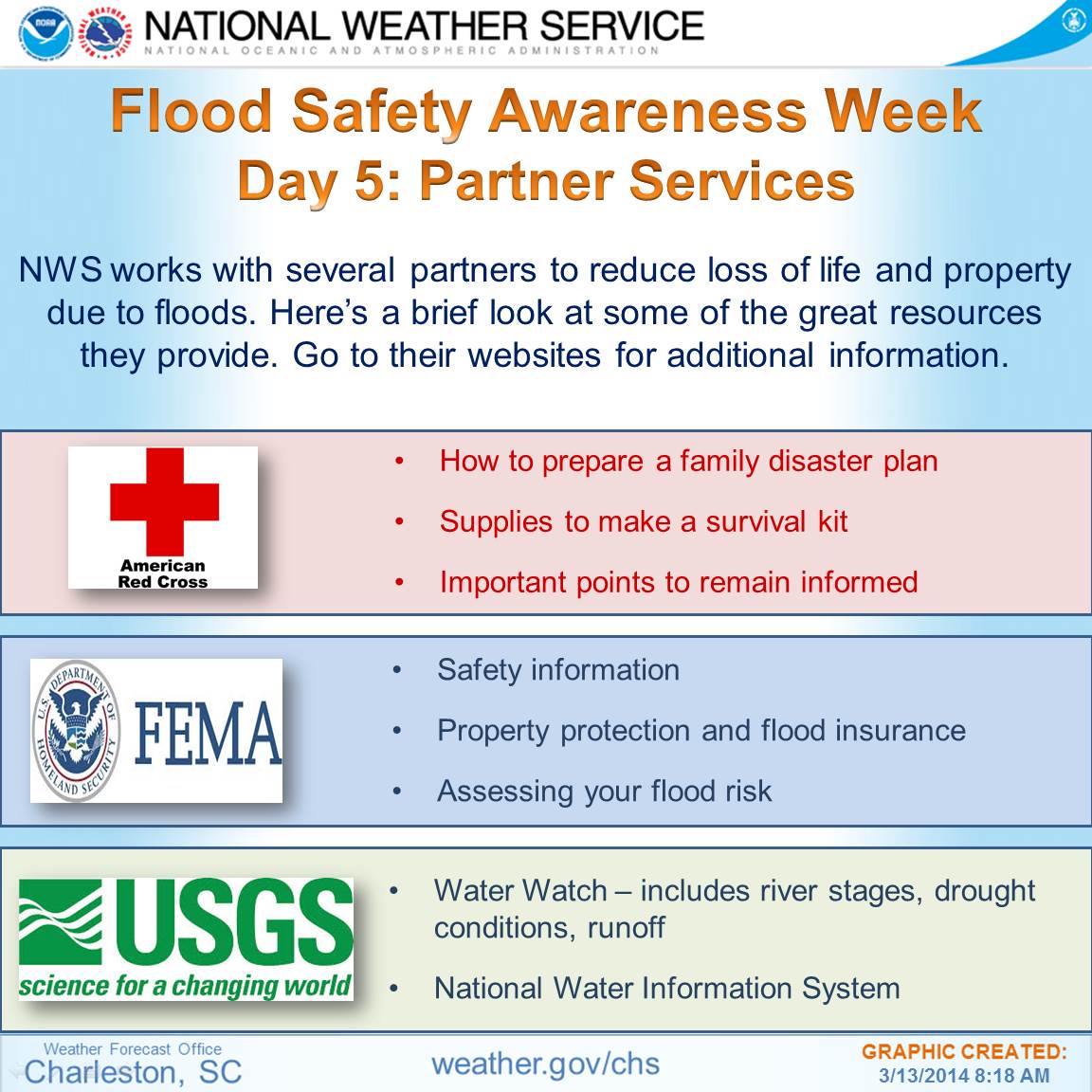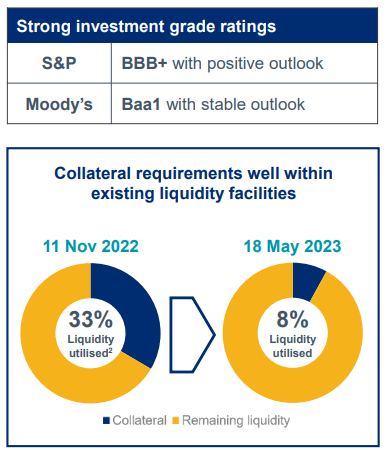Flood Safety During Severe Weather Awareness Week

Table of Contents
Understanding Flood Risks in Your Area
Knowing your flood risk is the first step towards effective flood safety. Many areas, even those not traditionally considered high-risk, are susceptible to flash floods or riverine flooding. Understanding your specific risk allows for targeted preparedness measures and informed decision-making during severe weather.
To assess your flood risk:
- Locate your property on a flood map: Most local governments and the Federal Emergency Management Agency (FEMA) provide online flood maps. These maps identify flood zones and indicate the likelihood of flooding in specific areas. Knowing your flood zone (e.g., high-risk, moderate-risk, minimal-risk) will help you determine your level of preparedness.
- Subscribe to local weather alerts and emergency notifications: Sign up for alerts from the National Weather Service (NWS) and your local emergency management agency. These alerts will provide timely warnings about impending severe weather, including flash flood watches and warnings.
- Understand different flood warnings: Familiarize yourself with the terminology used in flood warnings. A flood watch means conditions are favorable for flooding; a flood warning means flooding is occurring or is imminent; a flood advisory indicates minor flooding is possible.
- Identify potential flood sources near your home: Observe your surroundings to identify potential sources of flooding, such as nearby rivers, streams, creeks, or drainage areas. This awareness helps anticipate potential flood risks and allows for quicker response during a flood event.
Creating a Flood Preparedness Plan
A comprehensive flood preparedness plan is crucial for ensuring the safety and well-being of your family and protecting your property. This plan should encompass various aspects of emergency response, ensuring you're ready to act swiftly and effectively when a flood threatens.
Key components of a flood preparedness plan include:
- Assemble a flood emergency kit: This kit should include essential supplies for several days, such as non-perishable food, bottled water, a first-aid kit, medications, flashlights, batteries, a battery-powered radio, important documents (copies of insurance policies, identification, etc.), and warm clothing.
- Establish an evacuation route and meeting point: Plan multiple evacuation routes to higher ground, considering potential road closures. Designate a specific meeting point outside your immediate area in case of evacuation.
- Designate an out-of-area contact person: Choose someone outside your immediate area to serve as a central communication point for family members to check in.
- Review and update your homeowners or renters insurance policy: Ensure your insurance policy adequately covers flood damage. Flood insurance is often purchased separately from standard homeowner's insurance.
- Consider flood-proofing measures for your home: Depending on your risk level, consider measures such as installing flood barriers, elevating electrical systems, or waterproofing your basement.
Taking Action During a Flood Warning
When a flood warning is issued, swift and decisive action is critical. Your preparedness plan should guide your response, ensuring your safety and minimizing potential damage.
During a flood warning:
- Monitor weather reports closely: Stay updated on the latest weather forecasts and flood warnings.
- Move valuables to higher levels: Relocate important documents, electronics, and other valuables to upper floors or a safe, dry location.
- Turn off utilities (gas, electricity): This step helps prevent electrical shocks and gas leaks.
- Evacuate immediately if ordered: Obey all evacuation orders from authorities. Do not delay; floodwaters can rise rapidly.
- Never attempt to drive or walk through floodwaters: Floodwaters can be deeper and faster-moving than they appear, and even a small amount of water can sweep you off your feet.
- Seek shelter on higher ground: If evacuation isn't possible, move to the highest level of your home and stay there until the floodwaters recede.
Post-Flood Safety and Recovery
After the floodwaters recede, the recovery process begins. However, this phase also presents significant safety challenges. Careful attention to safety precautions is crucial for both physical well-being and avoiding further damage.
Post-flood safety and recovery steps:
- Avoid floodwaters; they may be contaminated: Floodwaters often contain sewage, chemicals, and other contaminants that can cause illness.
- Inspect your home for structural damage before re-entering: Check for cracks, weakened foundations, and other structural problems that could pose a safety risk.
- Document flood damage with photos and videos: This documentation will be essential when filing insurance claims.
- Contact your insurance company to file a claim: Follow the procedures outlined in your insurance policy to file a claim for flood damage.
- Seek assistance from local and federal disaster relief programs: Many organizations offer assistance with cleanup, repairs, and rebuilding after a flood.
Conclusion
Severe Weather Awareness Week underscores the importance of proactive flood safety measures. By understanding your risk, creating a preparedness plan, and taking appropriate actions during and after a flood, you significantly reduce the potential for harm and loss. This includes understanding flood risk assessment and utilizing flood maps to identify high-risk areas. Remember to create a comprehensive flood emergency kit and establish a clear communication and evacuation plan.
This Severe Weather Awareness Week, take control of your flood safety. Develop a comprehensive flood preparedness plan today and protect your family and home from the devastating effects of flooding. Learn more about flood safety resources in your area and stay informed about weather alerts. Proactive flood safety is not just about reacting to a crisis; it’s about proactively safeguarding your future.

Featured Posts
-
 Delaware Governor On The Threat Of Fascism A Critical Analysis Of The Post Trump Post Biden Landscape
May 26, 2025
Delaware Governor On The Threat Of Fascism A Critical Analysis Of The Post Trump Post Biden Landscape
May 26, 2025 -
 Slowing Growth Forces Sse To Cut Spending By 3 Billion
May 26, 2025
Slowing Growth Forces Sse To Cut Spending By 3 Billion
May 26, 2025 -
 Israeli Premier League Maccabi Tel Avivs Advantage
May 26, 2025
Israeli Premier League Maccabi Tel Avivs Advantage
May 26, 2025 -
 I Mercedes Apomakrynetai Apo Ton Verstappen
May 26, 2025
I Mercedes Apomakrynetai Apo Ton Verstappen
May 26, 2025 -
 Rtbf Et Rtl Belgium Strategies Pour Contrer L Iptv
May 26, 2025
Rtbf Et Rtl Belgium Strategies Pour Contrer L Iptv
May 26, 2025
